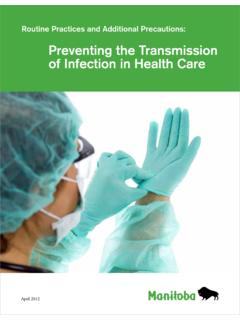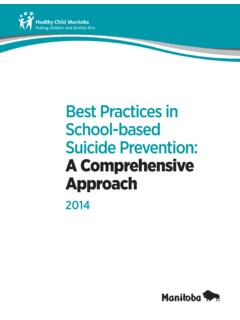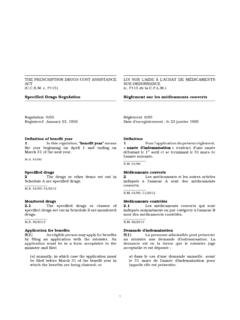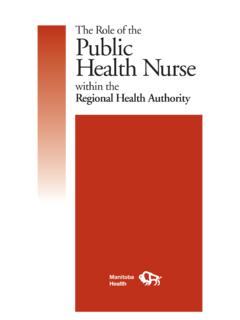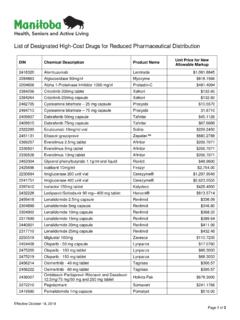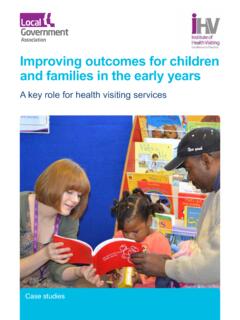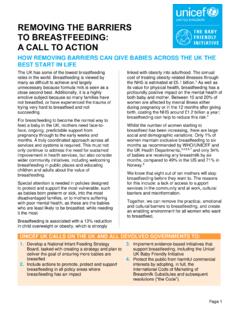Transcription of MANITOBA PROVINCIAL BREASTFEEDING STRATEGY
1 MANITOBA PROVINCIAL BREASTFEEDING STRATEGY 2013 INTRODUCTIONThe initial MANITOBA PROVINCIAL BREASTFEEDING STRATEGY was developed in the fall of 2006 to focus improvements, increase accountability and improve reporting on BREASTFEEDING . The BREASTFEEDING deliverable specified that RHAs develop frameworks and activities to improve BREASTFEEDING rates and to target percentage improvements in BREASTFEEDING initiation, duration and exclusive BREASTFEEDING to six months as recommended by Health Canada. The 2006 STRATEGY encouraged a coordinated approach to BREASTFEEDING promotion and support within each region and provincially. This STRATEGY was foundational in developing Baby Friendly MANITOBA working groups provincially and regionally and in advancing Baby Friendly Accreditation across the 2012, MANITOBA Health (MH) convened a working group involving multi-departmental stakeholders and RHAs to renew the BREASTFEEDING STRATEGY .
2 BACKGROUNDM anitoba Health promotes and supports efforts towards making BREASTFEEDING a priority and the normal nutritional choice for babies. MANITOBA Health recognizes BREASTFEEDING s positive impact on the health of all Manitobans. As the normal nutritional choice for infants, BREASTFEEDING optimizes child health and has been associated with reduced obesity, reduced chronic diseases including type 2 diabetes, improved oral health, and improved early childhood development especially for children born to low income mothers. BREASTFEEDING provides health care cost savings both in the present and the future. The Baby Friendly Initiative (BFI) is an international accreditation program developed by the World Health Organization and UNICEF for the protection, promotion and support of BREASTFEEDING .
3 Implementing the Baby Friendly Initiative, a program of evidence-based practice for maternal and infant health improves BREASTFEEDING outcomes. Globally, the Baby Friendly Initiative has increased BREASTFEEDING rates, reduced complications, and improved mothers health care experiences. Linkages and partnerships between the BREASTFEEDING STRATEGY and other PROVINCIAL relevant strategies and reports such as Health Living STRATEGY , Early Childhood Development, Maternal and Child Health Services (MACHS), Chronic Disease Prevention, Women s Health STRATEGY , Report on the Health Status of Manitobans and the Focussed on What Matters Most report will ensure consistent policy development in 2013 MANITOBA BREASTFEEDING STRATEGY contains four basic goals.
4 These goals are aligned with MANITOBA Health s departmental priorities and goals with emphasis on reducing health disparities; improving service delivery and building capacity. The goals are: Increase BREASTFEEDING initiation and exclusivity rates at discharge from hospital, birth centre, or following home birth Increase the rates of exclusive BREASTFEEDING to 6 months and continued BREASTFEEDING to 2 years and beyond Narrow the gap between BREASTFEEDING initiation, exclusivity and duration between northern and southern MANITOBA , urban, rural and isolated communities as well as between different socio-economic groups Achieve Baby Friendly Initiative accreditation in MANITOBA birthing hospitals.
5 Birth centres and community public health offices1 GUIDING PRINCIPLESG uiding principles are an integral part of the MANITOBA BREASTFEEDING STRATEGY , providing meaningful, practical guidelines that foster an environment where individuals, community agencies, government and academia can work together more effectively to improve BREASTFEEDING support and services. Recognize Diversity and Reduce InequityManitoba s families are diverse. Gender, race, ethnicity, culture, disability, age, income, geography and sexual orientation have an impact on BREASTFEEDING . All MANITOBA women need access to health services that take this diversity into account.
6 Understanding and addressing inequalities in BREASTFEEDING services and support is critical to improvement. A Holistic Approach Health promotion and delivery must care for the whole person. A family-centred approach promotes BREASTFEEDING health and wellness through education and prevention of disease, and reduces risk factors that are detrimental to the health of infants, mothers and families. Knowledge Building Knowledge building and knowledge translation about BREASTFEEDING is crucial to the baby friendly initiative. Collaboration among hospitals, community health sites and peer support programs provides consistency and connection to protect, promote and support BREASTFEEDING .
7 High quality research studies must be used to determine evidence-informed best practice regarding effective interventions, programs and activities to increase BREASTFEEDING initiation, exclusivity and duration. Collaboration and Coordination Addressing BREASTFEEDING issues requires the involvement of other levels of government and agencies. A coordinated and collaborative approach must be used which involves women in their communities, service providers, and all levels of government. This will improve coordination of policy, programs and services that impact Increase PROVINCIAL BREASTFEEDING initiation rates to 85% Increase exclusive BREASTFEEDING rates (including those infants who require medically indicated supplementation) at birth hospital/centre discharge to 75% Achieve improved BREASTFEEDING rates in the community including:a.
8 Exclusive BREASTFEEDING on entry to community service to 75%b. Duration of BREASTFEEDING at 6 months to 55% (25% exclusively breastfed)c. Continued BREASTFEEDING at 18 months to 25% By 2018, achieve Baby Friendly Initiative accreditation in 75% of all MANITOBA birthing hospitals/centres that have more than 100 births/year and 75% of all PROVINCIAL community public health offices STRATEGIC PRIORITIES AND ACTIONS:Priorities will evolve and new priorities will be identified as new evidence, funding and opportunities become available. Actions include existing and new activities from multi-sectoral government partnerships. Following are six initial priority areas to improve BREASTFEEDING rates, services and supports in ServicesPractice and information throughout the province will be consistent.
9 Health care providers and other multi-disciplinary providers will ensure early identification of issues and referral to appropriate services as and policies will meet the Baby Friendly best practice standard and will be compliant with 2the International Code of Marketing of Breast-Milk Substitutes. Strategic Actions: Increase consistent evidence based BREASTFEEDING education and training initiatives to enhance multi-disciplinary clinical capacity across the continuum of care by for health care providers, other team members and relevant para-professionals: Liaise with post-secondary institutions to include the appropriate level of BREASTFEEDING education for health care professionals working with infants and mothers Integrate the appropriate and required level of BREASTFEEDING education for professionals working directly with prenatal and postnatal families Improve services for women living in isolated, northern and rural areas by increasing.
10 Specialized BREASTFEEDING consultation or care availability of northern/rural BREASTFEEDING clinics and phone-in or distance supports for mothers prenatal and postnatal access to BREASTFEEDING information and supports to women travelling to give birth, both in transit and return to home community Develop Baby Friendly practices to support lab and DI services Establish a human milk bank in MANITOBA (compliant to HMBANA standards) with PROVINCIAL collection sites Integrate Baby Friendly designation into relevant accreditation, standards and guidelines in birthing facilities and community public health offices. Develop PROVINCIAL and RHA purchasing policies that meet the Baby Friendly best practice standard and comply with the International Code of Marketing of Breast-Milk Substitutes.
